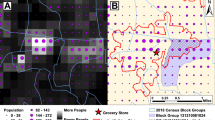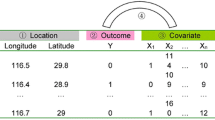Abstract
A common practice in spatial analysis is to represent the population of a spatial unit, such as a county or census tract, by a single point, and to use this point when measuring the distance between the population and other places such as service centers. In theoretical spatial systems, distance measurements obtained under this practice may differ from true distances by as much as eight percent, and the difference may be greater for real spatial systems. The presence and magnitude of these measurement errors have important implications for spatial analysis, and particularly for evaluating alternative facility location plans.
Similar content being viewed by others
References
Church, R. L. and C. S. ReVelle, “Theoretical and Computational Links Between the p-Median, Location Set-Covering and the Maximal Covering Problem,”Geographical Analysis, 8 (1976), pp. 406–415.
Goodchild, M. F. and B. H. Massam, “Some Least Cost Models of Spatial Administrative Systems in Southern Ontario,”Geografiska Annaler, 52B (1969), pp. 86–94.
Larson, R. C. and K. A. Stevenson, “On Insensitivities in Urban Redistricting and Facility Location,”Operations Research, 20 (1972), pp. 595–612.
Lea, A. C.Location-Allocation Systems: An Annotated Bibliography. Department of Geography, Discussion Paper No. 13, University of Toronto, Toronto, Ontario, 1973.
Lösch, A.The Economics of Location. Wolgam, W. H. and W. F. Stolper, trans. New Haven, Conn.: Yale University Press, 1954.
Neft, D. S.Statistical Analysis for Areal Distributions. Monograph Series No. 2, Regional Science Research Institute, University of Pennsylvania, Philadelphia, 1966.
Tornqvist, G., et al.Multiple Location Analysis. Lund Studies in Geography, Series C. General, Mathematical and Regional Geography, No. 12. Lund, Sweden: C. W. K. Gleerup, 1971.
Author information
Authors and Affiliations
Rights and permissions
About this article
Cite this article
Hillsman, E.L., Rhoda, R. Errors in measuring distances from populations to service centers. Ann Reg Sci 12, 74–88 (1978). https://doi.org/10.1007/BF01286124
Issue Date:
DOI: https://doi.org/10.1007/BF01286124




